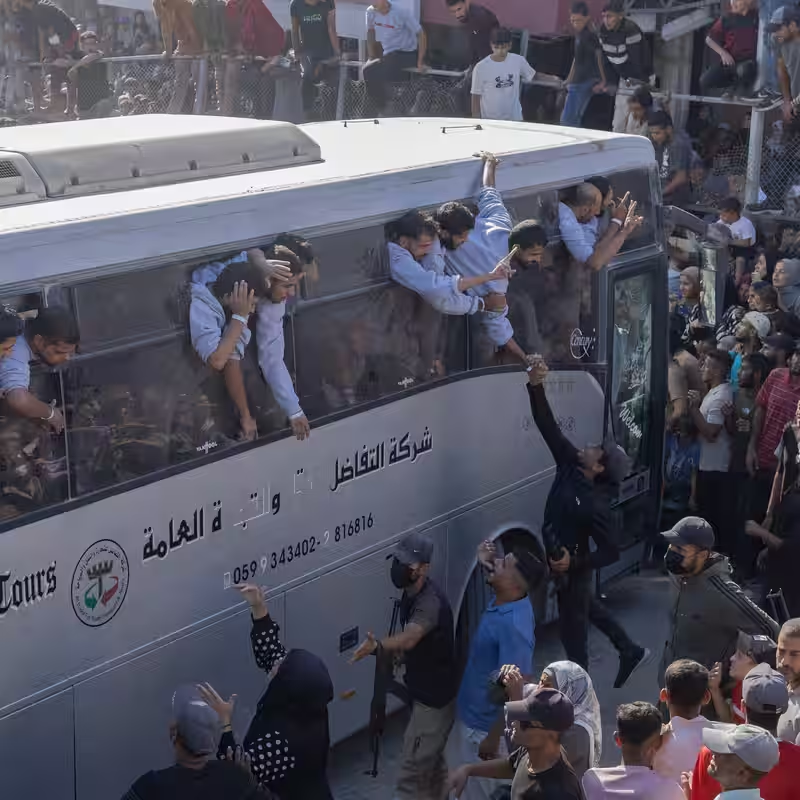Gaza Strip / Jerusalem – As part of a landmark cease-fire agreement between Israel and Hamas, nearly 2,000 Palestinian prisoners have been released from Israeli detention. The move marks one of the largest prisoner exchanges in the region’s recent history—but who exactly were these detainees?
Breaking Down the Palestinian Prisoner Release
The Palestinian prisoner release includes two distinct groups: 250 individuals convicted of involvement in violent attacks against Israelis, and more than 1,700 others detained from Gaza during the two-year war—many held without formal charges or trial.
According to Israeli and Palestinian sources, the released prisoners reflect the complex and often controversial nature of Israel’s detention policies during wartime.
Convicted Attackers Among the Freed
Of the 1,968 Palestinians released, 250 were serving long prison sentences—many with multiple life terms—for roles in deadly attacks on Israeli civilians and soldiers.
Among them:
- Imad Qawasmeh – A Hamas commander from Hebron, convicted of orchestrating a 2004 double suicide bombing in Beersheba that killed 16 people. He was serving 16 life sentences.
- Basem Khandaqji – A West Bank writer sentenced to three life terms for a 2004 Tel Aviv market bombing. While imprisoned, he became an acclaimed novelist and won the 2024 International Prize for Arabic Fiction.
- Ali Abdel Latif Mustafa Sais – A member of the Al-Aqsa Martyrs’ Brigades, arrested in 2005 and serving a life sentence. He returned to a hero’s welcome in Jenin.
Israel deported 154 of these high-profile prisoners to Egypt, citing concerns they would incite unrest or be celebrated as resistance figures. They are currently staying in a guarded Cairo hotel, awaiting uncertain futures.
Gazans Detained Without Charge
The majority of those released—1,718 individuals—were residents of Gaza detained during Israeli military operations since October 2023. Israel classified them as “unlawful combatants,” a designation that bypasses standard legal protections under both Israeli and international law.
Many were seized at checkpoints, shelters, hospitals, and even aid distribution sites. Rights groups, including HaMoked and the United Nations, have condemned these detentions as arbitrary and secretive, with some calling the practice a form of “forced disappearance.”
Notably, hundreds of medical personnel were among those detained. Dr. Ahmed Muhanna, director of Al-Awda Hospital in northern Gaza, spent 22 months in custody before his release this month. His colleague, Dr. Adnan Albursh, died in Israeli detention.
Deaths in Custody Raise Alarm
At least 78 Palestinians have died in Israeli custody since the war began, according to the Palestinian Prisoners Society. Reports from The New York Times and human rights organizations describe detainees being held in degrading conditions—stripped, beaten, and denied access to lawyers or family for months.
Israel maintains that all detainees are treated in accordance with international standards and denies systemic abuse.
Bodies of Deceased Prisoners Also Returned
As part of the cease-fire deal, Israel also returned the remains of nearly 200 deceased Palestinian prisoners—15 bodies for every deceased Israeli hostage handed over by Hamas. Forensic experts in Gaza report that most bodies arrived unidentified, bearing only numerical tags and signs of severe trauma.
What This Means for the Region
The Palestinian prisoner release is both a humanitarian gesture and a strategic concession. For families in Gaza and the West Bank, it offers long-awaited reunions. For Israel, it fulfills a key pillar of the truce while drawing criticism over its wartime detention practices.
With roughly 9,000 Palestinians still in Israeli custody, the issue of detention—and due process—remains far from resolved.
Sources
The New York Times – Who Were the 2,000 Palestinians Freed by Israel?
HaMoked: Center for the Defence of the Individual
United Nations Office for the Coordination of Humanitarian Affairs (OCHA)
Palestinian Prisoners Society




